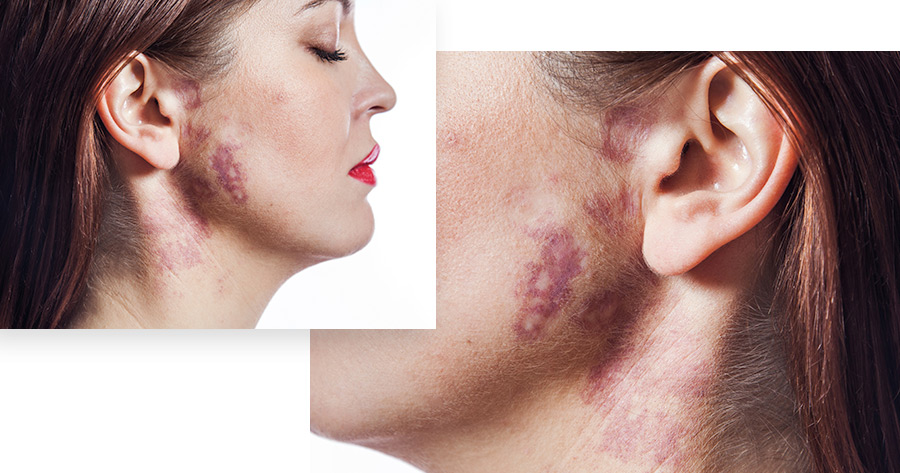What Are Port Wine Stains?
A port-wine stain is a benign birthmark that is caused by enlarged capillaries under the skins surface. These swollen capillaries produce a light pink to dark-red- violet discoloration of the skin. You may hear our doctors refer to this condition as nevus flammeus. Port-wine stains usually occur at birth and affect an estimated 3 children in every 1,000 live births. The condition is evenly distributed between males and females and across all races. The condition is not believed to be hereditary and there are no known risk factors that may lead to the development of the condition. In addition, there is not way to prevent a baby from being born with the condition. Port wine stains can be found anywhere on the body, however, it is common for them to present on the head and neck. Often the biggest problem people with port wine stains experience is low self esteem, and psychological issues due to their negative cosmetic appearance.



What Causes Port Wine Stains?
The cause of port wine stains is not completely understood by medical professionals. What doctors believe is that port wine stains develop as a result of deficient or absent neurons that would normally regulate blood flow through the skins capillaries. As a result, the blood vessels are unable to constrict normally and remain permanently enlarged giving off a pink to red appearance. It is important for mothers to be aware of the fact that port wine stains cannot be prevented and they do not develop as a result of an activity the mother engaged in while pregnant.
How Are Port Wine Stains Diagnosed?
Port wine stains can generally be diagnosed by a trained medical professional by simply looking at the skin. However, a skin biopsy may sometimes be performed. In some cases, an intraocular pressure test or x-ray of the skull may be performed as a means of diagnosing the conditions. An MRI or CT scan of the brain may also be done.
What Are The Symptoms of Port Wine Stains?
Port-wine stains are usually flat and pink in appearance. As one matures from childhood to adulthood, the presenting color may change to a dark red or purple. Over time, the area can become thickened and take on a cobblestone-like appearance. While in childhood port wine stains may not be a cause for concern, the same does not apply to adulthood. As the body ages, blood vessels become more dilated and susceptible to spontaneous bleeding following minor trauma. This can ultimately lead to the development of infection and other medical complications.
There are several treatment options for port wine stains. Call and make an appointment to speak with one of our doctors to determine which mode of treatment is best for you or your child. At Advanced Dermatology PC we pride ourselves on continuously updating our technology and training our doctors so that we can provide our patients with the latest and most effective forms of treatment.
In the past, port wine stains have been treated by freezing, surgery, tattooing, and radiation. These treatment options have shown limited success and have been replaced by cutting edge laser technology. In the most simple terms, a lasers works by destroying tiny blood vessels in the port-wine stain and thus, doing away with the discoloration in the skin.
Medical professionals have ranked the pulsed dye laser as the treatment of choice for port wine stains. This laser produces heat in the form of light which penetrates the skin and is absorbed by the hemoglobin in the blood. The heat destroys the blood vessel. This causes a temporary “bruised skin” look which will dissipate over time. Several treatments are often needed depending on the specifics and severity of the condition. Side effects from the laser include swelling and the bruised appearance as mentioned above. These side effects should subside within 2 weeks of treatment.
Make an appointment with one of our doctors to discuss how you should deal with your port wine stain condition.


Treatment
The most common treatment method for port wine stains utilizes pulsed dye lasers. A newer option, which uses optimized pulsed light lasers, was recently tested on port wine stains and other vascular lesions. Is newer necessarily better?
Small Sample Group, But Promising Results
Sixteen patients between the ages of 11 and 71 with vascular lesions underwent treatment by the optimized pulsed light laser. Ten of those patients saw an improvement of at least 50 percent within one to four treatment sessions and two of them even experienced full improvement after just one treatment session. No serious complications were noted after optimized pulsed light laser treatment. What does this mean for treating port wine stains and other vascular lesions?
Not a Replacement – Another Option
While the optimized pulsed light laser has shown promising results, researchers are quick to point out that it is not a replacement for pulsed dye lasers. Instead, it will be another option, for those who do not see results from pulsed dye lasers. Before it is accepted as a widespread treatment option, the optimized pulsed light laser must be analyzed further.